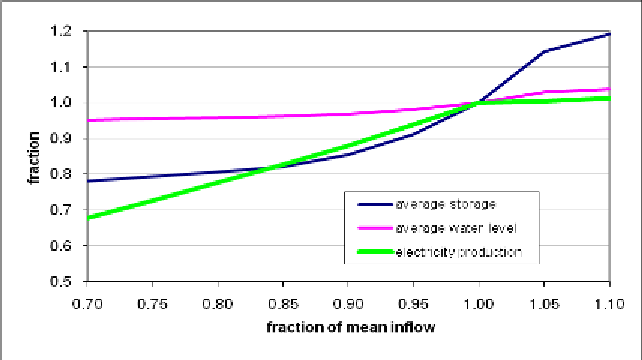Agriculture Reference
In-Depth Information
Area-Volume and Area-Stage relationships for Lake Volta. The surface area
(A in 10
6
m
2
) - Volume (V in 10
9
m
3
) relationship is given in Equation 8.7,
and Equation 8.8 relates surface area (A in 10
6
m
2
) and water depth y (m).
A = 155.1 x V
0.7921
(R
2
= 1) Equation 8.7
A = 129.01e
0.0493y
(R
2
= 0.9996) Equation 8.8
Model results gave a good fit of observed and modelled water levels
(r
2
=97.8%) and hydropower generation (99.8%). The Waflex model was then
used to assess the impact of reduced inflows on hydropower generation.
Figure 8.14 shows the impact of reduction in streamflow on reservoir storage
and reservoir levels and hydropower generation. Figure 8.15 provides more
detailed information on the effect of reduced inflows on the firm power
generation capacity.
If total inflow would reduce by 3.3 x 10
9
m
3
(fraction of historical inflow =
0.905), the average water level would drop by about 2.3m, average reservoir
storage would reduce by 4.9 x 10
9
m
3
, electricity generation would drop by
518GWh/yr. The loss of revenue from hydropower generation at Akosombo
due to the upstream irrigation in the White Volta sub-basin would thus be
about 42.5 million US$/a [calculated as 518*0.082=42.5].
As the net evaporation from the Volta Lake is estimated to be 265mm/a
(Friesen et al., 2005), the reduced inflows may lead to some savings from the
lake evaporation.
Figure 8.14
: Impact of change in inflow into Lake Volta on water level, storage
and electricity production, given historical operating policies.

Search WWH ::

Custom Search